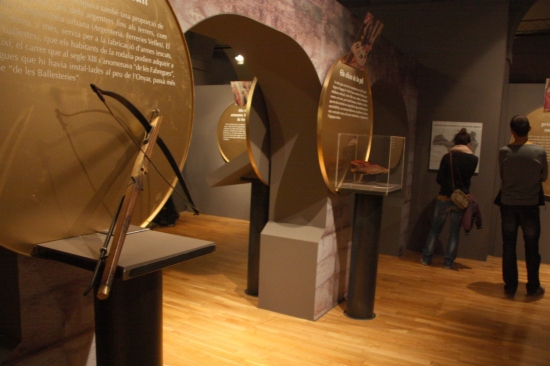The splendour of medieval Girona conveyed by 3 exhibitions
Three exhibitions convey the splendour of the city of Girona (in north-eastern Catalonia) during the Middle Ages. The curators of all three exhibitions wished to break away from the notion of “darkness” which is often associated with such times, when these several centuries actually shaped the city’s glorious past. Visitors can get acquainted with 13th century Jewish doctors or intellectuals, walk down the streets of Medieval Girona, and contemplate masterpieces such as the portrait of Catalan King Peter III. The City Museum, the Museum of Jewish History and the Monastery of Sant Daniel are hosting exhibitions on medieval Girona until the 30th of March 2014.

Girona (ACN).- The Medieval Girona left such a powerful impression on the city that even nowadays you can clearly see its influence over seven centuries of history. Three temporary exhibitions were unveiled a few days ago in three different spots of the Catalan city - the Monastery of St. Daniel, the Museum of Jewish History and the City History Museum. All three exhibitions delve into the splendour of medieval Girona, wishing to break away from the notion of “darkness” which is often and wrongfully so associated with such times. Visitors can get acquainted with 13th century Jewish doctors, poets or intellectuals, walk down the streets of the medieval city, and contemplate masterpieces such as the portrait of Catalan King Peter III from the National Art Museum of Catalonia (MNAC) or the polychrome image of praying Bernat Raset. These exhibitions will run until the 30th of March 2014.
More than 700 years separate the Roman Girona (Parva Gerunda) from the 16th century city. However, it is the centuries in between that have truly shaped its current appearance and image, so much so that “the best medieval exhibition we could see would be the actual city”, highlighted Jordi Sagrera, one of the curators of the City History Museum’s exhibition together with Marc Sureda. Sagrera explained that he is attempting to provide an “historical frame” for these three exhibitions so the visitors could understand the ways in which people lived in that period and their motivations.
Medieval Girona. The key of the kingdom
The City History Museum’s exhibition is called ‘Medieval Girona. The key of the kingdom’. The title aims at highlighting one of the crucial facts in the city’s development: during such times, Girona was at the crossroads between North and South Catalonia. The city truly became an economic and cultural centre as well as one of the hearts of religious, counts’ and royal powers. In short, it was to become the second most important city in Catalonia. “We owe a lot to this city” admitted the Director of the Girona History Museum, Sílvia Planas. She explained that the purpose of these three exhibitions is to give a new interpretation of the medieval city’s great impact. According to her, it was equally important to break away from the idea of “darkness” that was usually associated with the medieval period, when it was actually a “magnificent, and powerful time, full of contrasts”, she said.
Although the exhibition is not intended as a display of “works”, it does highlight a few, notably the polychromatic image of praying Bernat Raset. Until this day, the masterpiece had been exclusively guarded by the Cathedral of Girona and had never been shown to the public. Another masterpiece on show is the portrait of Catalan King Peter III, which has been loaned by the National Museum of Art of Catalonia (MNAC). In addition, sketches by Jordi Sagrera depicting medieval Girona are also put on display so that visitors can imagine themselves walking on the medieval streets of the city.
The legacy of the Jewish community
The Museum of Jewish History focused on this community and its legacy to the north-eastern Catalan city. The exhibition ‘Jewish Girona, City Mother of Israel’ depicts the Jewish Quarter of Girona, where many doctors, poets, philosophers and astronomers lived. The great cultural and intellectual activity of Girona’s Jewish community enabled the city to achieve international recognition. Visitors can see the Town Charter of the Costa Brava town of Palamós, a political document signed by Jew Astruc Ravaia on the King’s behalf in 1279. The exhibition also displays a wide collection of pottery and domestic objects provided by the Catalan Museum of Archaeology (MAC-Girona). Jordi Sagrera’s drawings showing the evolution of the Jewish Quarter’s streets during the Middle Ages are also on show.
Monastic architecture
Finally, the exhibition ‘The Monastery of St. Daniel during Medieval Times’ delves into the fascinating history of the monastery, its typical medieval architecture and the social and human aspects. It highlights the active role of nuns and countesses in promoting art and culture. The exhibition also puts on display the oldest documents of the three exhibitions: a document on the foundation of the monastery which dates back to 1018 and some pieces of Romanesque art.
Open until 30th March 2014
All three exhibitions will run until the 30th of March and will be accompanied by a wide array of activities for all ages. They have been organised by Girona’s City Council and funded by the History Museum of Girona, with the cooperation of the Trust of the Jewish Quarter and the Monastery of St. Daniel.
The exhibitions’ official opening, the Mayor of Girona, Carles Puigdemont, stated he was “very proud” of the city’s medieval past that allowed to understand the current city. He also thanked the institutions and the individuals who, by their active involvement, had made the exhibitions possible.